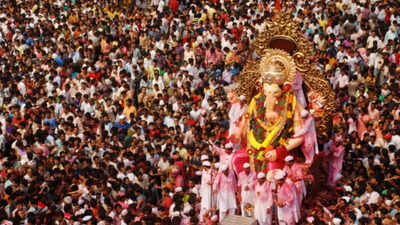Ganesh Chaturthi 2025: 6 timeless Ganesha folklores from the Puranas with hidden lessons for students

Ganesh Chaturthi is not just about clay idols, sweets, and celebrations; it is also about rediscovering the wisdom hidden in ancient Puranic tales of Lord Ganesha. For students navigating exams, careers, and life choices, these stories are more than mythology—they are timeless lessons in resilience, humility, discipline, and intellect. Each folklore reminds us that success is not about shortcuts or pride, but about clarity, devotion, and perseverance.
The story of Ganesha’s lost head
The most famous origin tale of Lord Ganesha is narrated in the Shiva Purana (Rudra-saṃhita, Kumāra-khaṇḍa). Goddess Parvati, while preparing for her bath, fashioned a boy from the turmeric paste she used on her body. This child, Ganesha, was given the duty of guarding her privacy.When Lord Shiva attempted to enter, the child stopped him at the door. Unaware that Ganesha was Parvati’s creation, Shiva grew furious at being challenged by a mere boy. In his rage, he severed Ganesha’s head with his trident.Parvati’s grief knew no bounds, and she demanded her son be brought back to life. Shiva, realising his error, instructed his followers to bring the head of the first living being they encountered facing north. They returned with the head of a young elephant, which Shiva placed upon Ganesha’s body, reviving him. From that day, Ganesha became the beloved elephant-headed deity, worshipped as the remover of obstacles.Life lesson for students: Even the gravest setbacks can be transformed into new beginnings. Like Ganesha’s revival with an elephant head, students must learn to adapt and grow from failures instead of fearing them.
The race around the world
This charming tale, preserved in the Skanda Purana, tells of a contest between Ganesha and his brother Kartikeya. Their parents, Shiva and Parvati, offered a divine fruit of wisdom, to be awarded to whichever son could circle the world three times and return first.Kartikeya immediately mounted his peacock and set off on a long, arduous journey around the globe. Ganesha, recognising his own physical limitations due to his round belly and mouse vehicle, paused to think. With deep reverence, he simply circled his parents, declaring, “For me, you are the entire world.”Shiva and Parvati were moved by his wisdom and devotion. They awarded the fruit to Ganesha, proving that true understanding often lies in seeing the essence rather than the surface.Life lesson for students: True wisdom is about perspective, not speed. While others may rush to compete, students who think deeply and value essentials—like Ganesha recognising his parents as his world—often gain the greater reward.
Why Ganesha has a broken tusk
Two prominent legends explain Ganesha’s broken tusk:
- In the Brahmanda Purana, Sage Vyasa asked Ganesha to write down the Mahabharata as he dictated it. Ganesha agreed on the condition that Vyasa would not stop speaking. In the middle of the dictation, when his pen broke, Ganesha broke off one of his tusks and used it as a stylus to ensure the task continued without interruption. This sacrifice symbolised his commitment to knowledge and perseverance.
- In another version from the Padma Purana, Ganesha lost his tusk in a clash with Parashurama, an avatar of Vishnu. When Parashurama’s axe—blessed by Shiva—was hurled at Ganesha, he did not defend himself, out of respect for his father’s weapon. The blow broke his tusk, but his reverence and humility were immortalised in the legend.
Life lesson for students: Knowledge demands sacrifice. Whether it’s long study hours or persistence through broken tools (like Ganesha using his tusk as a pen), real learning comes from perseverance and respect for wisdom.
The curse of the moon and why Ganesha is worshipped first
The Brahma Vaivarta Purana (Ganesha Khanda) narrates that on one Ganesh Chaturthi night, Ganesha, after a hearty feast of sweets, rode on his mouse. The little mouse stumbled upon seeing a snake, causing Ganesha to fall. The moon god, Chandra, laughed at this sight.Angered, Ganesha cursed Chandra, saying anyone who looked at him on Ganesh Chaturthi would face false accusations and dishonour. The gods pleaded for mercy, and the curse was softened: instead of total disgrace, the moon would wax and wane each month, and humans could avoid the curse by listening to the story of Syamantaka Mani.It was also decreed that Ganesha must be worshipped first in every ritual, ensuring his blessings before any endeavour. This tale explains why even today, Hindus begin ceremonies with prayers to Ganesha.Life lesson for students:Pride and mockery can backfire. Students should avoid arrogance in achievement and remember that humility and sincerity win respect, just as Ganesha’s primacy in worship arose from teaching the moon a lesson in pride.
Ganesha as Vyasa’s scribe for the Mahabharata
The monumental Mahabharata was composed by sage Vyasa but required a scribe who could keep up with his rapid dictation. As narrated in the Mahabharata (Anushasana Parva) and elaborated in the Brahmanda Purana, Ganesha accepted the role, on one condition: Vyasa could not pause.Vyasa agreed but cleverly added his own condition: Ganesha must fully understand each verse before writing it down. This allowed Vyasa to maintain control, dictating complex, layered verses that gave him time to compose while also ensuring the epic’s philosophical depth was preserved.Thus, Ganesha became the scribe of the Mahabharata, symbolising intellect, patience, and devotion to knowledge.Life lesson for students: Discipline in learning is about balance—speed with understanding. Like Vyasa and Ganesha, students must ensure they truly grasp concepts instead of rushing through studies without comprehension.
The tale of Kubera’s feast and Ganesha’s hunger
One of the most delightful yet humbling tales of Ganesha’s childhood appears in multiple Puranic traditions, particularly the Shiva Purana (Rudra-saṃhita, Yuddha-khaṇḍa, Chapters 16–18) and retellings in the Ganesha Purana (Krida-khanda).Kubera, the lord of wealth and king of Alakapuri, was immensely proud of his riches. To display his grandeur, he invited Lord Shiva and Goddess Parvati to a lavish banquet. Shiva, instantly recognising Kubera’s arrogance, declined the invitation but sent little Ganesha in his place.When Ganesha arrived, his appetite seemed boundless. As described in the Ganesha Purana, he devoured every dish prepared in Kubera’s kitchens. Yet his hunger remained unsatisfied. He then began consuming Kubera’s stores of grain, his gold, his jewels, and, as the Shiva Purana notes, even threatened to eat the wealth-lord himself if food was not forthcoming.A terrified Kubera fled to Kailasa, begging Shiva and Parvati for relief. Parvati smiled and gave him a simple handful of aval (puffed rice). With humility, Kubera offered this meagre portion to Ganesha. To his astonishment, the boy’s hunger was immediately satisfied.Life lesson for students: Wealth and display mean little without humility. For students, this means valuing sincerity and hard work over superficial show—true nourishment of the mind comes from simplicity and devotion, not empty pride.TOI Education is on WhatsApp now. Follow us here.





